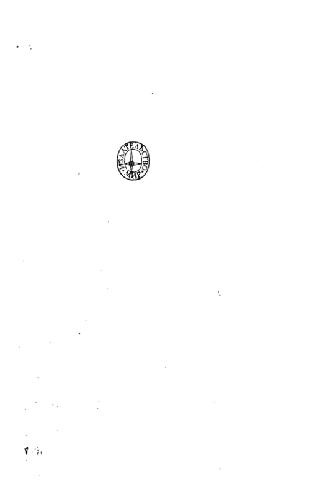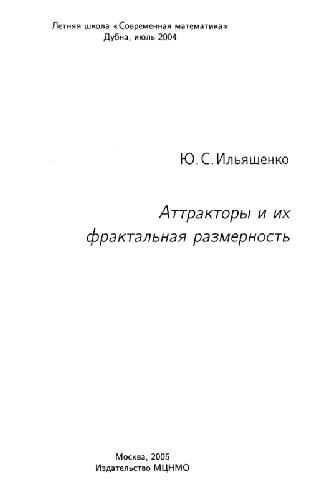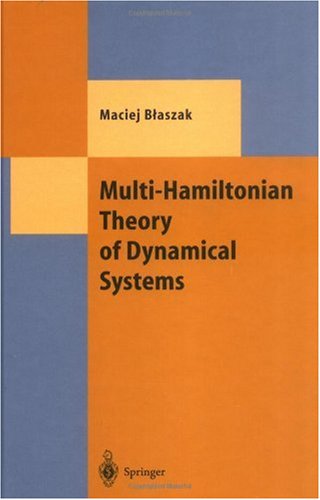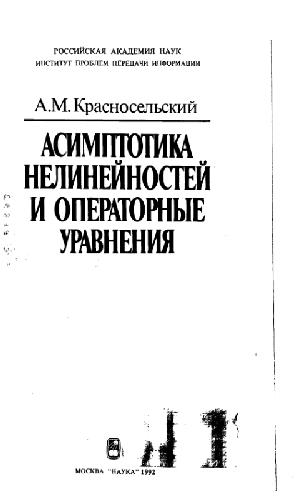Nikolai, Alexandrovich Magnitskii, Sergey Vasilevich Sidorov9789812568175, 981-256-817-4
Table of contents :
Contents……Page 12
Preface……Page 8
1.1.2 Vector fields, differential equations, integral and phase curves……Page 19
1.1.3 Theorems of existence and uniqueness of solutions……Page 21
1.1.4 Differentiable dependence of solutions from initial conditions and parameters, the equations in variations……Page 22
1.1.5 Dissipative and conservative systems of differential equations……Page 23
1.1.6 Numerical methods for solution of systems of ordinary differential equations……Page 24
1.1.7 Ill-posedness of numerical methods in solution of systems of ordinary differential equations……Page 25
1.2.1 Singular points of systems of ordinary differential equations……Page 26
1.2.2 Stability of singular points and stationary solutions……Page 27
1.2.3 Invariant manifolds……Page 29
1.2.4 Singular points of linear vector fields……Page 31
1.2.5 Separatrices of singular points, homoclinic and heteroclinic trajectories, separatrix contours……Page 33
1.3.2 Limit cycles……Page 35
1.3.3 Poincare map……Page 38
1.3.4 Invariant tori……Page 43
1.4.1 Basic definitions……Page 48
1.4.2 Classical regular attractors of dissipative systems of ordinary differential equations……Page 50
1.4.3 Classical irregular attractors of dissipative dynamical systems……Page 52
1.4.4 Dimension of attractors, fractals……Page 59
2.1.1 Structural stability……Page 63
2.1.2 Bifurcations……Page 65
2.2.1 Bifurcations of stable singular points……Page 68
2.2.2 Bifurcations of stable limit cycles……Page 75
2.2.3 Bifurcations of stable two-dimensional tori……Page 89
2.3 The Simplest Two-Parametrical Local Bifurcations……Page 93
2.3.1 The normal form of a fold……Page 94
2.3.2 The normal form of an assembly……Page 95
2.4.1 Bifurcations of homoclinic separatrix contours……Page 97
2.4.2 Bifurcations of heteroclinic separatrix contours……Page 106
2.4.3 Approximate method for finding bifurcation points of separatrix contours of singular points……Page 110
2.4.4 Cascades of bifurcations, scenarios of transition to chaos……Page 116
2.4.5 Bifurcations of irregular (singular) attractors……Page 122
3.1.1 Classical scenario of birth of the Lorenz attractor……Page 125
3.1.2 Scenario of birth of the Lorenz attractor through an incomplete double homoclinic cascade of bifurcations……Page 128
3.1.3 Scenario of birth of a complete double homoclinic attractor in the Lorenz system……Page 145
3.1.4 Bifurcations of homoclinic and heteroclinic contours in the Lorenz system……Page 159
3.1.5 Diagrams of nonlocal bifurcations in the Lorenz system……Page 168
3.2 The Complex System of Lorenz Equations……Page 170
3.2.1 Scenario of transition to chaos……Page 173
3.3 Systems of the Rossler Equations……Page 177
3.4 The Chua System……Page 182
3.5.1 The Vallis systems……Page 188
3.5.2 The Rikitaki system……Page 197
3.5.3 The “Simple” system……Page 201
3.5.4 The Rabinovich-Fabrikant system……Page 205
3.6 Final Remarks and Conclusions……Page 208
4. Principles of the Theory of Dynamical Chaos in Dissipative Systems of Ordinary Differential Equations……Page 209
4.1 Theory of One-Dimensional Smooth Mappings……Page 211
4.1.1 Monotonic invertible mappings……Page 213
4.1.2 Nonmonotonic mappings……Page 217
4.2.1 Logistic mapping……Page 218
4.2.2 Period doubling operator……Page 222
4.2.3 Feigenbaum universality……Page 225
4.2.4 Dimension of the Feigenbaum attractor……Page 230
4.3.1 The Sharkovskii’s theorem……Page 231
4.3.2 Behind the Feigenbaum cascade……Page 240
4.4 Dynamical Chaos in Two-Dimensional Non-Autonomous Systems of Differential Equations……Page 241
4.4.1 Rotor type singular points……Page 242
4.4.2 Scenario of transition to chaos……Page 245
4.4.3 Dynamical chaos in some classical two-dimensional non-autonomous systems……Page 249
4.5 Dynamical Chaos in Three-Dimensional Autonomous Systems of Differential Equations……Page 255
4.5.1 Singular cycles of three-dimensional autonomous systems……Page 256
4.5.2 Singular attractors of three-dimensional autonomous systems……Page 260
4.5.3 Some examples of three-dimensional autonomous systems with singular attractors……Page 267
4.6 Final Remarks and Conclusions……Page 277
5. Dynamical Chaos in Infinite-Dimensional Systems of Differential Equations……Page 279
5.1 Regular Dynamics and Diffusion Chaos in Reaction-Diffusion Systems……Page 280
5.1.1 Turing and Andronov-Hopf bifurcations in the Brusselator model……Page 281
5.1.2 Diffusion chaos for the Brusselator in a ring……Page 285
5.1.3 Diffusion chaos in the Brusselator on a segment……Page 287
5.2 Transition to Spatio-Temporal Chaos in the Kuramoto-Tsuzuki Equation……Page 289
5.2.1 Scenario of transition to chaos in system of few-mode approximations……Page 291
5.2.2 Transition to chaos in the space of Fourier coefficients……Page 296
5.2.3 Scenario of transition to chaos in the phase space of the Kuramoto-Tsuzuki equation……Page 299
5.3 Dynamical Chaos in Differential Equations with Delay Argument……Page 305
5.4.1 Description of the model of self-developing market economy……Page 309
5.4.2 Behavior of macroeconomic variables……Page 317
5.4.3 Behavior of economic variables in the presence of diffusion of capital and consumer demand……Page 322
6. Chaos Control in Systems of Differential Equations……Page 327
6.1 Ott-Grebogi-Yorke and Pyragas methods……Page 328
6.1.1 The OGY-method……Page 329
6.1.2 The Pyragas method……Page 330
6.2 The Magnitskii Method……Page 331
6.2.1 Localization and stabilization of unstable fixed points and unstable cycles of chaotic mappings……Page 332
6.2.2 Localization and stabilization of unstable fixed points of chaotic dynamical systems……Page 339
6.2.3 Localization and stabilization of unstable cycles of chaotic dynamical systems……Page 342
6.2.4 Chaos control in equations with delay argument……Page 348
6.2.5 Stabilization of a thermodynamic branch in reaction-diffusion systems of equations……Page 355
6.3 Reconstruction of Dynamical System on Trajectory of Irregular Attractor……Page 365
Bibliography……Page 369
Index……Page 377







Reviews
There are no reviews yet.